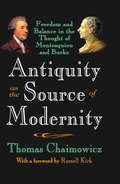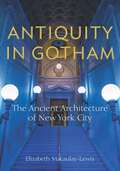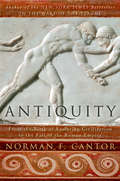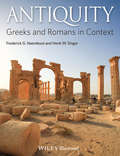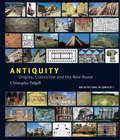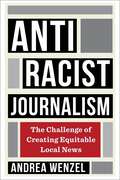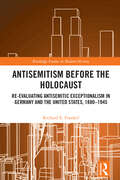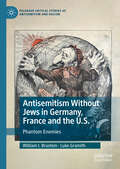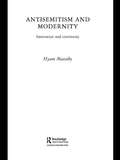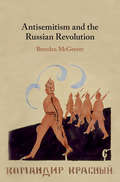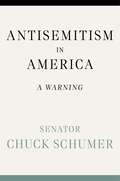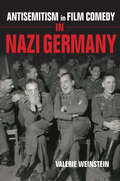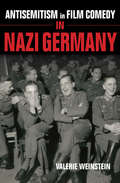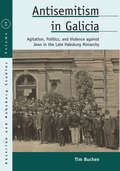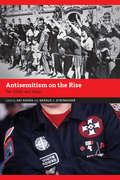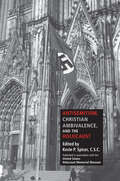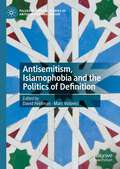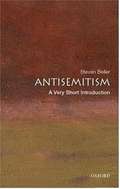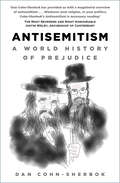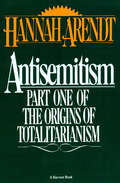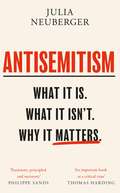- Table View
- List View
Antiquity as the Source of Modernity: Freedom and Balance in the Thought of Montesquieu and Burke
by Thomas ChaimowiczThis is a book that contrary to common practice, shows the commonalities of ancient and modern theories of freedom, law, and rational actions. Studying the works of the ancients is necessary to understanding those that follow. Thomas Chaimowicz challenges current trends in research on antiquity in his examination of Montesquieu's and Burk's path of inquiry. He focuses on ideas of balance and freedom. Montesquieu and Burke believe that freedom and balance are closely connected, for without balance within a state there can be no freedom.When Montesquieu speaks of republics, he means those of antiquity as they were understood in the eighteenth century. In this view, freedom can develop only within the framework of established tradition. Edmund Burke's greatest service to political thought may lie in making use of this idea when he fought against the abstractions of the French Revolutionaries. Antiquity as the Source of Modernity examines Montesquieu's Roman mind, meaning not an attitude influenced by the ancients, but one primarily influenced by Roman heritage. It speaks to the antithesis of monarchy and despotism in Montesquieu's thought and the influence of Tacitus and Pliny the Younger on him. The separation of powers and its relation to the concept of the mixed constitution as well as Montesquieu's smaller masterpiece Considerations on the Causes of the Grandeur and Decadence of the Romans are examined in detail. Finally, the discussion leads seamlessly to Burke, who, as a critical admirer of Montesquieu, partly incorporated his interpretation of the English constitution into his own thinking threatened by teachings of the French Revolution and its British adherents.The central idea of Antiquity as the Source of Modernity is timeless. It is that the ancient past can lead to a clearer understanding of what follows. This perspective represents a reversal of the conventional procedures for conducting this kind of research,
Antiquity in Gotham: The Ancient Architecture of New York City
by Elizabeth Macaulay-LewisThe first detailed study of “Neo-Antique” architecture applies an archaeological lens to the study of New York City’s structuresSince the city’s inception, New Yorkers have deliberately and purposefully engaged with ancient architecture to design and erect many of its most iconic buildings and monuments, including Grand Central Terminal and the Soldiers’ and Sailors’ Memorial Arch in Brooklyn, as well as forgotten gems such as Snug Harbor on Staten Island and the Gould Memorial Library in the Bronx. Antiquity in Gotham interprets the various ways ancient architecture was re-conceived in New York City from the eighteenth century to the early twenty-first century. Contextualizing New York’s Neo-Antique architecture within larger American architectural trends, author Elizabeth Macaulay-Lewis applies an archaeological lens to the study of the New York buildings that incorporated these various models in their design, bringing together these diverse sources of inspiration into a single continuum. Antiquity in Gotham explores how ancient architecture communicated the political ideals of the new republic through the adaptation of Greek and Roman architecture, how Egyptian temples conveyed the city’s new technological achievements, and how the ancient Near East served many artistic masters, decorating the interiors of glitzy Gilded Age restaurants and the tops of skyscrapers. Rather than classifying neo-classical (and Greek Revival), Egyptianizing, and architecture inspired by the ancient Near East into distinct categories, Macaulay-Lewis applies the Neo-Antique framework that considers the similarities and differences—intellectually, conceptually, and chronologically—among the reception of these different architectural traditions. This fundamentally interdisciplinary project draws upon all available evidence and archival materials—such as the letters and memos of architects and their patrons, and the commentary in contemporary newspapers and magazines—to provide a lively multi-dimensional analysis that examines not only the city’s ancient buildings and rooms themselves but also how New Yorkers envisaged them, lived in them, talked about them, and reacted to them. Antiquity offered New Yorkers architecture with flexible aesthetic, functional, cultural, and intellectual resonances—whether it be the democratic ideals of Periclean Athens, the technological might of Pharaonic Egypt, or the majesty of Imperial Rome. The result of these dialogues with ancient architectural forms was the creation of innovative architecture that has defined New York City’s skyline throughout its history.
Antiquity: From the Birth of Sumerian Civilization to the Fall of the Roman Empire
by Norman F. CantorBestselling author Norman Cantor delivers this compact but magisterial survey of the ancient world--from the birth of Sumerian civilization around 3500 B.C. in the Tigris-Euphrates valley (present-day Iraq) to the fall of the Roman Empire in A.D. 476. In Antiquity, Cantor covers such subjects as Classical Greece, Judaism, the founding of Christianity, and the triumph and decline of Rome.In this fascinating and comprehensive analysis, the author explores social and cultural history, as well as the political and economic aspects of his narrative. He explains leading themes in religion and philosophy and discusses the environment, population, and public health. With his signature authority and insight, Cantor highlights the great books and ideas of antiquity that continue to influence culture today.
Antiquity: Greeks and Romans in Context
by Henk W. Singor Frederick G. NaereboutAntiquity: Greeks and Romans in Context provides a chronological introduction to the history of ancient Mediterranean civilizations within the larger context of its contemporary Eurasian world. Innovative approach organizes Greek and Roman history into a single chronology Combines the traditional historical story with subjects that are central to modern research into the ancient world including a range of social, cultural, and political topics Facilitates an understanding of the ancient Mediterranean world as a unity, just as the Mediterranean world is in its turn presented as part of a larger whole Covers the entire ancient Mediterranean world from pre-history through to the rise of Islam in the seventh century A.D. Features a diverse collection of images, maps, diagrams, tables, and a chronological chart to aid comprehension English translation of a well-known Dutch book, De oudheid, now in its third edition
Antiquity: Origins, Classicism and The New Rome
by Christopher TadgellThe first in a new series of five books describing and illustrating the seminal architectural traditions of the world, Antiquity traces architectural history from its very beginnings until the time when the traditions that shape today’s environments began to flourish. More than a catalogue of buildings, in this work Tadgell provides their political, technological, social and cultural contexts and explores architecture, not only as the development of form and space but as an expression of the civilization within which it evolves. The buildings are analyzed and illustrated with over 1200 colour photographs and 400 drawings while the societies that produced them are brought to life through a broad selection of their artefacts.
Antiquity: The Civilization of the Ancient World
by Norman CantorHighly readable history from about 4000 B.C. to 1500.
Antiracist Journalism: The Challenge of Creating Equitable Local News
by Andrea WenzelAcross the United States, newsrooms are grappling with systemic racism in their organizations and the media industry. Many have implemented diversity, equity, and inclusion (DEI) initiatives or made other attempts to confront past and present biases in pursuit of greater equity. Are such efforts merely performative, or are any transforming norms and power structures? What would it take to hold newsrooms truly accountable?Andrea Wenzel provides a critical look at how local media organizations in the Philadelphia area are attempting to address structural racism. She focuses on two established, majority-white newsrooms, the Philadelphia Inquirer and the public radio station WHYY, and two start-ups where at least half the staff identify as Black, Indigenous, or people of color (BIPOC), Resolve Philly and Kensington Voice. Drawing on more than five years of field research, Wenzel charts how these outlets have pursued a range of interventions—such as tracking the diversity of sources, examining reporting and editing practices, and working with community members to gain input—to varying degrees of success. Wenzel argues that institutional and systemic transformation will be possible only through the establishment of structures that facilitate holding those with more power responsible for listening to and addressing the needs and concerns of those with less. Offering recommendations for building infrastructure that enables sustainable accountability, Antiracist Journalism is an important book for everyone interested in making local journalism more equitable.
Antisemitic Myths: A Historical and Contemporary Anthology
by Marvin Perry Frederick M. SchweitzerThis anthology presents 90 documents that focus on the nature, evolution and meaning of the principle myths that have made anti-Semitism such a lethal force in history: Jews as deicides, ritual murderers, agents of Satan, international conspirators, and conniving, unscrupulous Shylocks.
Antisemitism Before the Holocaust: Re-Evaluating Antisemitic Exceptionalism in Germany and the United States, 1880-1945 (Routledge Studies in Modern History)
by Richard E. FrankelThis book examines the history of antisemitism in the United States and Germany in a novel way by placing the two countries side by side for a sustained comparison of the anti-Jewish environments in both countries from the 1880s to the end of World War II. Author Richard E. Frankel shatters the widely held notion of exceptionalism in Germany and America: the belief that antisemitism in Germany was uniquely murderous and led inevitably to the Holocaust and that antisemitism in the United States was uniquely benign, making an American Holocaust all but unthinkable. In a series of new and previously published essays that have been revised, updated, and expanded, the book relates antisemitism to issues including Jewish and Chinese immigration, discrimination and exclusion, World War I and its aftermath, Hitler and Henry Ford, Nazis, the American Right, and the Roosevelt Administration, and a German Ku Klux Klan. Taken together, these essays reveal that antisemitism in Germany was less aberrant than commonly believed and that American antisemitism was indeed dangerous and more similar to what existed in Germany during the same period. Antisemitism Before the Holocaust is an essential volume for students and scholars alike interested in European and American history, the history of the Holocaust and World War I.
Antisemitism Without Jews in Germany, France and the U.S.: Phantom Enemies (Palgrave Critical Studies of Antisemitism and Racism)
by William I. Brustein Luke GramithWhy does antisemitic messaging strike a chord in certain communities without Jews but fall flat in neighboring communities equally without Jews? This book focuses on antipathy towards Jews - expressed through successful electoral campaigns where a candidate or political party championed antisemitism - in communities located in three different nations where the Jewish population had virtually no history of interaction with the resident majority population of non-Jews. The cases are: the election of antisemitic deputies in the 1893 German Reichstag Elections from eastern Saxony; the election of a slate of antisemitic deputies to the French Chamber in 1898 from the southwestern French department of the Gers; and the significant proportion of votes for the antisemitic campaign of Gerald B. Winrod in the U.S. Senate Republican Party primary election in 1938 in Kansas. Each of these examples illustrates the existence of heightened levels of antisemitism in cases where few, if any, Jews had engagement with the majority population.
Antisemitism and Modernity: Innovation and Continuity (Routledge Jewish Studies Series)
by Hyam MaccobyThe subject of anti-Semitism, not long ago thought to be a dead issue, has been revised due to the conflict between Israel and the Palestinians. Maccoby traces the now topical discussion of the origins of Anti-Semitism, and especially its development in the modern world. The key questions that are addressed include: How is it that this medieval prejudice proved so lasting and potent? Are the roots of anti-Semitism religious? If so, how do these roots differ in Christianity and Islam? By what means did it bridge the gap between medievalism and Enlightenment? How was it that many of the most respected Enlightenment figures (such as Voltaire) dedicated as they were to tolerance and pluralism, retained a virulent anti-Semitism? These questions, and many more, are dealt with as Maccoby explores the roots of the anti-Semitism, tracing it from its origins, and shows how it has changed in accordance with the shifting ideas of the modern world but without changing in its essence. Antisemitism and Modernity is essential reading for those with interests in the development of anti-Semitism, its manifestation in the current world and its future.
Antisemitism and the Russian Revolution
by Brendan McGeeverWhen the Bolsheviks came to power in 1917, they announced the overthrow of a world scarred by exploitation and domination. In the very moment of revolution, these sentiments were put to the test as antisemitic pogroms swept the former Pale of Settlement. The pogroms posed fundamental questions of the Bolshevik project, revealing the depth of antisemitism within sections of the working class, peasantry and Red Army. Antisemitism and the Russian Revolution offers the first book-length analysis of the Bolshevik response to antisemitism. Contrary to existing understandings, it reveals this campaign to have been led not by the Party leadership, as is often assumed, but by a loosely connected group of radicals who mobilized around a Jewish political subjectivity. By examining pogroms committed by the Red Army, Brendan McGeever also uncovers the explosive overlap between revolutionary politics and antisemitism, and the capacity for class to become racialized in a moment of crisis.
Antisemitism in America: A Warning
by Chuck SchumerIn an urgent and personal new book, Democratic Leader Chuck Schumer, the highest-elected Jewish official in America, sheds light on the Jewish American experience and sounds the alarm about the troubling resurgence of antisemitism. <p> For the first time in generations, antisemitism has become a daily reality in America, and it’s getting worse. Jewish synagogues and their congregants are targeted and sometimes killed by extremists, Jewish students are harassed and attacked on campus, conspiracy theories about Jews have gone mainstream on social media, and debates over Israel have veered into dangerous territory. <p> Senator Chuck Schumer tackles the historical, political, cultural, and international forces that have led to the alarming rise of antisemitism in America in the 21st Century. ANTISEMITISM IN AMERICA: A WARNING is a timely work of nonfiction that illuminates his generation’s Jewish experience. From Brooklyn in the 1960s to Harvard in the 1970s to the inside of a secure bunker on January 6, 2021, Schumer takes readers on a personal journey of how Jewish Americans like him have come to understand their history, their place in America—and why they worry about the future of Jewish life in America. This book is a warning, informed by the lessons of history, about what can happen when the world’s oldest hatred is allowed to rise unchecked. <b>New York Times Bestseller</b>
Antisemitism in Film Comedy in Nazi Germany
by Valerie WeinsteinToday many Germans remain nostalgic about "classic" film comedies created during the 1930s, viewing them as a part of the Nazi era that was not tainted with antisemitism. In Antisemitism in Film Comedy in Nazi Germany, Valerie Weinstein scrutinizes these comic productions and demonstrates that film comedy, despite its innocent appearance, was a critical component in the effort to separate "Jews" from "Germans" physically, economically, and artistically. Weinstein highlights how the German propaganda ministry used directives, pre- and post-production censorship, financial incentives, and influence over film critics and their judgments to replace Jewish "wit" with a slower, simpler, and more direct German "humor" that affirmed values that the Nazis associated with the Aryan race. Through contextualized analyses of historical documents and individual films, Weinstein reveals how humor, coded hints and traces, absences, and substitutes in Third Reich film comedy helped spectators imagine an abstract "Jewishness" and a "German" identity and community free from the former. As resurgent populist nationalism and overt racism continue to grow around the world today, Weinstein’s study helps us rethink racism and prejudice in popular culture and reconceptualize the relationships between film humor, national identity, and race.
Antisemitism in Film Comedy in Nazi Germany (Encounters: Explorations in Folklore and Ethnomusicology)
by Valerie WeinsteinHow party propagandists worked behind the scenes to create unspoken racist messages in the German culture—even in the most lighthearted of movies. Today many Germans look back fondly on 1930s film comedies, viewing them as a part of the Nazi era that was not tainted with antisemitism. Here, Valerie Weinstein scrutinizes these comic productions and demonstrates that film comedy, despite its innocent appearance, was a critical component in the effort to separate &“Jews&” from &“Germans&” physically, economically, and artistically. Weinstein highlights how the German propaganda ministry used directives, pre- and post-production censorship, financial incentives, and influence over film critics and their judgments to replace Jewish &“wit&” with a slower, simpler, and more direct German &“humor&” that affirmed values that the Nazis associated with the Aryan race. Through contextualized analyses of historical documents and individual films, Weinstein reveals how humor, coded hints and traces, absences, and substitutes in Third Reich film comedy helped spectators imagine an abstract &“Jewishness&” and a &“German&” identity and community free from the former. As resurgent populist nationalism and overt racism continue to grow around the world today, Weinstein&’s study helps us rethink racism and prejudice in popular culture and reconceptualize the relationships between film, humor, national identity, and race.
Antisemitism in Galicia: Agitation, Politics, and Violence against Jews in the Late Habsburg Monarchy (Austrian and Habsburg Studies #29)
by Tim BuchenIn the last third of the nineteenth century, the discourse on the “Jewish question” in the Habsburg crownlands of Galicia changed fundamentally, as clerical and populist politicians emerged to denounce the Jewish assimilation and citizenship. This pioneering study investigates the interaction of agitation, violence, and politics against Jews on the periphery of the Danube monarchy. In its comprehensive analysis of the functions and limitations of propaganda, rumors, and mass media, it shows just how significant antisemitism was to the politics of coexistence among Christians and Jews on the eve of the Great War.
Antisemitism in Galicia: Agitation, Politics, and Violence against Jews in the Late Habsburg Monarchy (Austrian and Habsburg Studies #29)
by Tim BuchenIn the last third of the nineteenth century, the discourse on the “Jewish question” in the Habsburg crownlands of Galicia changed fundamentally, as clerical and populist politicians emerged to denounce the Jewish assimilation and citizenship. This pioneering study investigates the interaction of agitation, violence, and politics against Jews on the periphery of the Danube monarchy. In its comprehensive analysis of the functions and limitations of propaganda, rumors, and mass media, it shows just how significant antisemitism was to the politics of coexistence among Christians and Jews on the eve of the Great War.
Antisemitism on the Rise: The 1930s and Today (Contemporary Holocaust Studies)
by Ari Kohen Gerald J. SteinacherWe live in uncertain and unsettling times. Tragically, today&’s global culture is rife with violent bigotry, nationalism, and antisemitism. The rhetoric is not new; it is grounded in attitudes and values from the 1930s and the 1940s in Europe and the United States.Antisemitism on the Rise is a collection of essays by some of the world&’s leading experts, including Joseph Bendersky, Jean Cahan, R. Amy Elman, Leonard Greenspoon, and Jürgen Matthäus, regarding two key moments in antisemitic history: the interwar period and today. Ari Kohen and Gerald J. Steinacher have collected important examples on this crucial topic to illustrate new research findings and learning techniques that have become increasingly vital with the recent rise of white supremacist movements, many of which have a firm root in antisemitism. Part 1 focuses on the antisemitic beliefs and ideas that were predominant during the 1930s and 1940s, while part 2 draws comparisons between this period and today, including examples of ways to teach others about contemporary antisemitism. The volume seeks to inform readers about the historical progression of antisemitism and in doing so asks readers to think about what is at stake and how to bridge the gap between research and teaching.
Antisemitism, Christian Ambivalence, and the Holocaust
by Kevin P. SpicerIn recent years, the mask of tolerant, secular, multicultural Europe has been shattered by new forms of antisemitic crime. Though many of the perpetrators do not profess Christianity, antisemitism has flourished in Christian Europe. In this book, thirteen scholars of European history, Jewish studies, and Christian theology examine antisemitism's insidious role in Europe's intellectual and political life. The essays reveal that annihilative antisemitic thought was not limited to Germany, but could be found in the theology and liturgical practice of most of Europe's Christian churches. They dismantle the claim of a distinction between Christian anti-Judaism and neo-pagan antisemitism and show that, at the heart of Christianity, hatred for Jews overwhelmingly formed the milieu of 20th-century Europe.
Antisemitism, Islamophobia and the Politics of Definition (Palgrave Critical Studies of Antisemitism and Racism)
by David Feldman Marc VoloviciThis book, the first to explore the politics of definitions from an interdisciplinary perspective, encourages readers to reconsider the value and limits of definitions in confronting antisemitism and Islamophobia. In recent years, definitions of antisemitism and Islamophobia have become central to the struggle to combat the hostility, harassment and discrimination experienced by Jews and Muslims. Yet these definitions have also provoked fierce controversy: critics have questioned whether they are fit for purpose, or have criticised them as unwelcome attempts to restrict freedom of expression. In this edited collection, historians, social scientists and philosophers reflect on definitions of antisemitism and Islamophobia in both the past and the present. Its contributors investigate the different historical contexts which have shaped definitions and examine their different political purposes and meanings, as well as addressing contemporary debates, and identifying ways for us to move beyond our current impasse. This book therefore provides a broad and new perspective from which to comprehend present day minority politics.
Antisemitism: A Very Short Introduction
by Steven BellerThis Very Short Introduction examines and untangles the various strands of antisemitism seen throughout history, from medieval religious conflict to 'new' antisemitism in the 21st century. Steven Beller reveals how the phenomenon grew as a political and ideological movement in the 19th century, how it reached it its dark apogee in the worst genocide in modern history - the Holocaust - and how antisemitism still persists around the world today.
Antisemitism: A World History of Prejudice
by Dan Cohn-Sherbok‘Dan Cohn-Sherbok has provided us with a magisterial overview of antisemitism . . . Whatever your religion, or your politics, Cohn-Sherbok’s Antisemitism is necessary reading.’ The Most Reverend and Right Honourable Justin Welby, Archbishop of Canterbury‘A very readable overview on four millennia of Judaeophobia . . . a timely book and shows the flame of antisemitism continues to burn bright.’ Rabbi Professor Walter HomolkaAntisemitism has featured in the history of Western civilization for over 3,000 years. Dan Cohn-Sherbok traces its origins and its manifestations, from political opposition to racial persecution to religious and philosophical justification for some of history’s most outrageous acts. Against this background of intolerance and persecution, Cohn-Sherbok describes Jewish emancipation from the late eighteenth century and its gradual transformation into the parallel political and nationalistic ideal of Zionism.Antisemitism: A World History of Prejudice offers a clear and readable account of why antisemitism has featured so strongly in world history, and provides extensive discussion of the issues that exist to this day. Unlike most studies of the subject, it does not focus exclusively on Christian antisemitism, but explores the origins of Arab and organized Communist antisemitism and Nazi racism.Brought right up to date with an exploration of how modern-day antisemitism ought to be defined in order to combat it, this revised edition is essential reading not only for history students and theologians, but anyone interested in learning about why the Jews have been hated for so long.
Antisemitism: Part One of The Origins of Totalitarianism (The Origins of Totalitarianism #1)
by Hannah ArendtIn the first volume of her landmark philosophical work, The Origins of Totalitarianism, the political theorist traces the rise of antisemitism in Europe. Since it was first published in 1951, The Origins of Totalitarianism has been recognized as the definitive philosophical account of the totalitarian mindset. A probing analysis of Nazism, Stalinism, and the &“banality of evil&”, it remains one of the most referenced works in studies and discussions of totalitarian movements around the world.In this first volume, Antisemitism, Dr. Hannah Arendt traces the rise of antisemitism to Central and Western European Jewish history during the 19th century. With the appearance of the first political activity by antisemitic parties in the 1870s and 1880s, Arendt states, the machinery that led to the horrors of the Holocaust was set in motion. The Dreyfus Affair, in Arendt&’s view, was &“a kind of dress rehearsal&”—the first modern use of antisemitism as an instrument of public policy and of hysteria as a political weapon.&“The most original and profound—therefore the most valuable—political theorist of our times.&”—Dwight MacDonald, The New Leader
Antisemitism: What It Is. What It Isn't. Why It Matters
by Julia NeubergerAntisemitism has been on the rise in recent years, with violent attacks, increased verbal insults, and an acceptability in some circles of what would hitherto have been condemned as outrageous antisemitic discourse. Yet despite the dramatic increase in debate and discussion around antisemitism, many of us remain confused. In this urgent and timely book, Rabbi Julia Neuberger uses contemporary examples, along with historical context, to unpack what constitutes antisemitism, building a powerful argument for why it is so crucial that we come to a shared understanding now.
Antisemitism: What It Is. What It Isn't. Why It Matters
by Julia NeubergerThere has been a disturbing rise in antisemitism in Europe over the last fifteen years or so, with violent attacks on Jewish targets, increased verbal antisemitism, and an acceptability in many circles of what would hitherto have been condemned as outrageous antisemitic discourse. More recently, the Labour party have come under fire for engaging in antisemitic abuse. Yet despite the dramatic increase in debate and discussion around antisemitism, there is a general sense of confusion about what should and shouldn't be defined as antisemitism - and particularly around criticism of the State of Israel.In this urgently needed book, Rabbi Julia Neuberger uses contemporary examples, along with historical context, to unpack what constitutes antisemitism, building a powerful argument for why it is so crucial that we come to a shared understanding now, and exploring ways of dealing with it.
